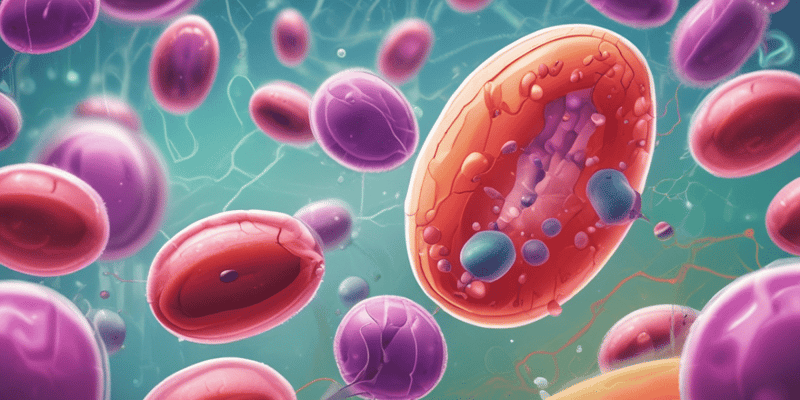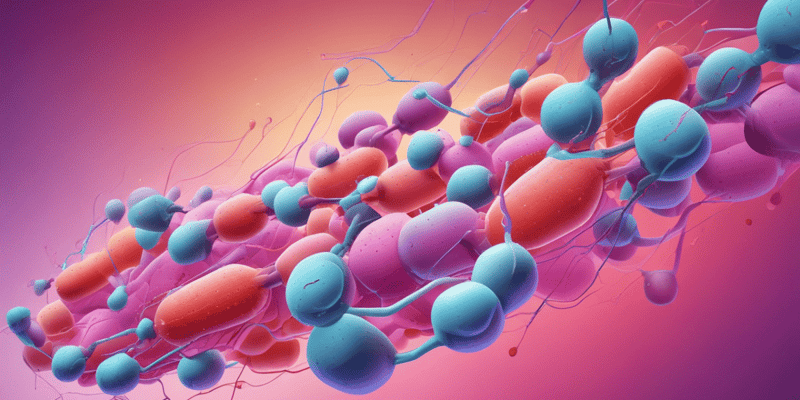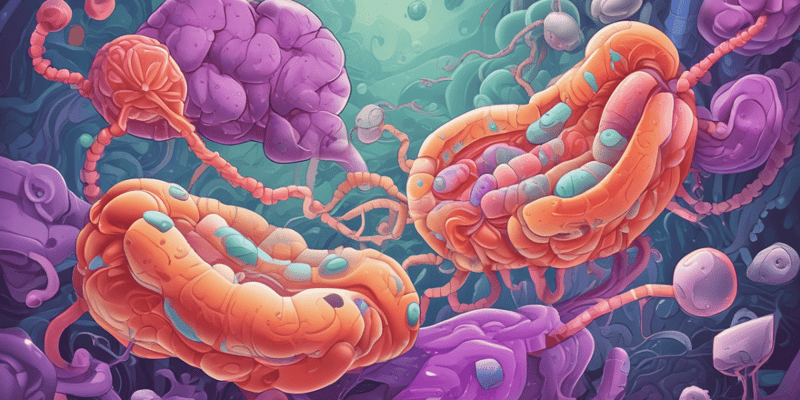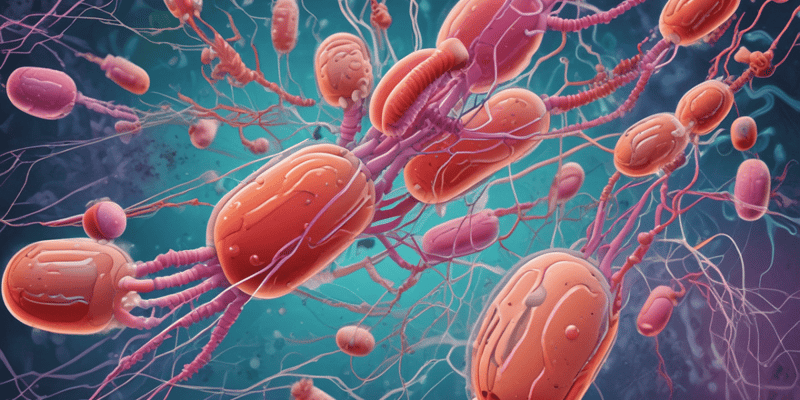Podcast
Questions and Answers
What is the primary reason for the rapid increase of CRAB?
What is the primary reason for the rapid increase of CRAB?
What is the main characteristic of Acinetobacter baumannii that makes it difficult to treat?
What is the main characteristic of Acinetobacter baumannii that makes it difficult to treat?
What is the significance of Acinetobacter baumannii being listed as one of the main targets for the treatment and development of new antibiotics by the World Health Organization?
What is the significance of Acinetobacter baumannii being listed as one of the main targets for the treatment and development of new antibiotics by the World Health Organization?
What is the consequence of Acinetobacter baumannii's ability to easily adapt to changes in the environment?
What is the consequence of Acinetobacter baumannii's ability to easily adapt to changes in the environment?
Signup and view all the answers
What is the primary site of infection associated with high mortality in patients with A.baumannii infection?
What is the primary site of infection associated with high mortality in patients with A.baumannii infection?
Signup and view all the answers
Why is Acinetobacter baumannii categorized as a superbug?
Why is Acinetobacter baumannii categorized as a superbug?
Signup and view all the answers
What is the main challenge in treating infections caused by CRAB?
What is the main challenge in treating infections caused by CRAB?
Signup and view all the answers
What is the focus of the present study?
What is the focus of the present study?
Signup and view all the answers
What is the primary function of resistance-associated genes in microorganisms?
What is the primary function of resistance-associated genes in microorganisms?
Signup and view all the answers
What is the main challenge in treating infections with carbapenem-resistant Acinetobacter (CRA)?
What is the main challenge in treating infections with carbapenem-resistant Acinetobacter (CRA)?
Signup and view all the answers
What was the primary outcome of the study mentioned in the content?
What was the primary outcome of the study mentioned in the content?
Signup and view all the answers
What is the limitation of covalent inhibitors in treating CRAB infections?
What is the limitation of covalent inhibitors in treating CRAB infections?
Signup and view all the answers
Which of the following antibiotics is associated with a favorable clinical outcome in the treatment of CRAB infections?
Which of the following antibiotics is associated with a favorable clinical outcome in the treatment of CRAB infections?
Signup and view all the answers
What is the mechanism of action of β-lactamases?
What is the mechanism of action of β-lactamases?
Signup and view all the answers
What is the most common adverse event occurring in hospitalized patients?
What is the most common adverse event occurring in hospitalized patients?
Signup and view all the answers
What is the purpose of β-lactamase inhibitors in treating bacterial infections?
What is the purpose of β-lactamase inhibitors in treating bacterial infections?
Signup and view all the answers
What is the characteristic of non-covalent inhibitors?
What is the characteristic of non-covalent inhibitors?
Signup and view all the answers
What is the primary mechanism of antibiotic resistance in A. baumannii?
What is the primary mechanism of antibiotic resistance in A. baumannii?
Signup and view all the answers
What is the frequency of carbapenem-hydrolyzing oxacillinase 23 beta-lactamase in A. baumannii?
What is the frequency of carbapenem-hydrolyzing oxacillinase 23 beta-lactamase in A. baumannii?
Signup and view all the answers
What is the advantage of non-covalent inhibitors over covalent inhibitors?
What is the advantage of non-covalent inhibitors over covalent inhibitors?
Signup and view all the answers
What is the significance of the discovery of non-beta-lactam beta-lactamase inhibitors?
What is the significance of the discovery of non-beta-lactam beta-lactamase inhibitors?
Signup and view all the answers
What is the primary reason for the increasing antimicrobial resistance in A. baumannii?
What is the primary reason for the increasing antimicrobial resistance in A. baumannii?
Signup and view all the answers
What is the primary function of beta-lactam antibiotics?
What is the primary function of beta-lactam antibiotics?
Signup and view all the answers
What is the global situation regarding the prevalence of carbapenem-resistant Acinetobacter baumannii (CRAB)?
What is the global situation regarding the prevalence of carbapenem-resistant Acinetobacter baumannii (CRAB)?
Signup and view all the answers
What is the primary concern in treating CRAB infections in patients with comorbid conditions?
What is the primary concern in treating CRAB infections in patients with comorbid conditions?
Signup and view all the answers
What is the significance of antimicrobial resistance genes in the environment?
What is the significance of antimicrobial resistance genes in the environment?
Signup and view all the answers
What is the primary reason for the limited options for treating CRAB infections?
What is the primary reason for the limited options for treating CRAB infections?
Signup and view all the answers
What is the year in which A. baumannii began to exhibit resistance to colistin?
What is the year in which A. baumannii began to exhibit resistance to colistin?
Signup and view all the answers
What is the primary mechanism of action of most BL inhibitors?
What is the primary mechanism of action of most BL inhibitors?
Signup and view all the answers
What is the characteristic feature of boronic acid inhibitors?
What is the characteristic feature of boronic acid inhibitors?
Signup and view all the answers
What is the advantage of using non-beta-lactam beta-lactamase inhibitors?
What is the advantage of using non-beta-lactam beta-lactamase inhibitors?
Signup and view all the answers
What is the significance of the study conducted by Lomovskaya O et al. in 2019?
What is the significance of the study conducted by Lomovskaya O et al. in 2019?
Signup and view all the answers
What is the characteristic feature of class D enzymes?
What is the characteristic feature of class D enzymes?
Signup and view all the answers
What is the mechanism of action of the sodium adduct of compound 17?
What is the mechanism of action of the sodium adduct of compound 17?
Signup and view all the answers
What is the significance of the potent non-beta-lactam-beta-lactamase inhibitors?
What is the significance of the potent non-beta-lactam-beta-lactamase inhibitors?
Signup and view all the answers
What is the mechanism of action of durlobactam?
What is the mechanism of action of durlobactam?
Signup and view all the answers
What is the advantage of using nitrile group in non-beta-lactam beta-lactamase inhibitors?
What is the advantage of using nitrile group in non-beta-lactam beta-lactamase inhibitors?
Signup and view all the answers
What is the mechanism of action of MSD Star?
What is the mechanism of action of MSD Star?
Signup and view all the answers
What is the reason behind the poor clinical outcomes in patients with CRAB infections?
What is the reason behind the poor clinical outcomes in patients with CRAB infections?
Signup and view all the answers
What is the main location of the New Delhi Metallo-β-lactamase-1 gene in CRABs?
What is the main location of the New Delhi Metallo-β-lactamase-1 gene in CRABs?
Signup and view all the answers
What is the primary aim of the study mentioned in the content?
What is the primary aim of the study mentioned in the content?
Signup and view all the answers
What is the main driving force behind new investigations into the treatment of CRAB infection?
What is the main driving force behind new investigations into the treatment of CRAB infection?
Signup and view all the answers
What is the main reason for the critical unmet need for new antibiotics with activity against CRAB?
What is the main reason for the critical unmet need for new antibiotics with activity against CRAB?
Signup and view all the answers
What is the main function of antibiotic resistance in A. baumannii?
What is the main function of antibiotic resistance in A. baumannii?
Signup and view all the answers
What is the main reason behind the selection of empiric antibiotics in patients with hospital-associated infections?
What is the main reason behind the selection of empiric antibiotics in patients with hospital-associated infections?
Signup and view all the answers
What are the three antibiotics commonly utilized to treat patients with CRAB infections?
What are the three antibiotics commonly utilized to treat patients with CRAB infections?
Signup and view all the answers
What is the current status of the antibiotic pipeline for novel antibiotics?
What is the current status of the antibiotic pipeline for novel antibiotics?
Signup and view all the answers
What is the main challenge posed by the emergence of carbapenem-resistant Acinetobacter baumannii?
What is the main challenge posed by the emergence of carbapenem-resistant Acinetobacter baumannii?
Signup and view all the answers
What is the primary concern regarding Carbapenem-resistant A.baumannii (CRAB) infections?
What is the primary concern regarding Carbapenem-resistant A.baumannii (CRAB) infections?
Signup and view all the answers
Which of the following beta-lactamases are the main beta-lactamases of CRAB?
Which of the following beta-lactamases are the main beta-lactamases of CRAB?
Signup and view all the answers
What is the primary mechanism of action of non-beta-lactam beta-lactamase inhibitors?
What is the primary mechanism of action of non-beta-lactam beta-lactamase inhibitors?
Signup and view all the answers
What is the primary concern regarding the development of new antibiotics for CRAB infections?
What is the primary concern regarding the development of new antibiotics for CRAB infections?
Signup and view all the answers
What is the primary advantage of non-beta-lactam antibiotics in treating CRAB infections?
What is the primary advantage of non-beta-lactam antibiotics in treating CRAB infections?
Signup and view all the answers
Which of the following is NOT a non-beta-lactam antibiotic used to treat CRAB infections?
Which of the following is NOT a non-beta-lactam antibiotic used to treat CRAB infections?
Signup and view all the answers
What is the primary consequence of the widespread multiplicity of beta-lactamase-mediated resistance?
What is the primary consequence of the widespread multiplicity of beta-lactamase-mediated resistance?
Signup and view all the answers
What is the primary challenge in treating CRAB infections?
What is the primary challenge in treating CRAB infections?
Signup and view all the answers
What is the primary mechanism of action of beta-lactamase inhibitors?
What is the primary mechanism of action of beta-lactamase inhibitors?
Signup and view all the answers
Which of the following is a novel non-beta-lactam beta-lactamase inhibitor?
Which of the following is a novel non-beta-lactam beta-lactamase inhibitor?
Signup and view all the answers
What is the primary concern regarding the use of combination treatment in the clinic?
What is the primary concern regarding the use of combination treatment in the clinic?
Signup and view all the answers
What is the criterion for classifying CRAB according to the CDC?
What is the criterion for classifying CRAB according to the CDC?
Signup and view all the answers
What is the primary goal of developing non-beta-lactam molecules against A. baumannii?
What is the primary goal of developing non-beta-lactam molecules against A. baumannii?
Signup and view all the answers
What is the primary limitation of avibactam against A. baumannii?
What is the primary limitation of avibactam against A. baumannii?
Signup and view all the answers
What is the purpose of developing beta-lactamase inhibitors with broad-spectrum activities?
What is the purpose of developing beta-lactamase inhibitors with broad-spectrum activities?
Signup and view all the answers
What is the primary advantage of WXC210?
What is the primary advantage of WXC210?
Signup and view all the answers
What is the primary characteristic of the Zinc-Evolved Cyclic-DEPI-Lactamase Inhibitor?
What is the primary characteristic of the Zinc-Evolved Cyclic-DEPI-Lactamase Inhibitor?
Signup and view all the answers
What is the primary concern regarding the use of beta-lactamase inhibitors in a real clinical setting?
What is the primary concern regarding the use of beta-lactamase inhibitors in a real clinical setting?
Signup and view all the answers
What is the primary reason for the rapid increase in antibiotic resistance among pathogenic bacterial species?
What is the primary reason for the rapid increase in antibiotic resistance among pathogenic bacterial species?
Signup and view all the answers
What is the primary goal of monitoring the inhibitory activities of serine-type beta-lactamase inhibitors against CRAB?
What is the primary goal of monitoring the inhibitory activities of serine-type beta-lactamase inhibitors against CRAB?
Signup and view all the answers
What is the primary mechanism by which beta-lactam inhibitors inactivate beta-lactamases?
What is the primary mechanism by which beta-lactam inhibitors inactivate beta-lactamases?
Signup and view all the answers
What is the significance of the discovery of non-beta-lactam beta-lactamase inhibitors?
What is the significance of the discovery of non-beta-lactam beta-lactamase inhibitors?
Signup and view all the answers
What is the primary advantage of non-beta-lactam beta-lactamase inhibitors over beta-lactam inhibitors?
What is the primary advantage of non-beta-lactam beta-lactamase inhibitors over beta-lactam inhibitors?
Signup and view all the answers
What is the primary reason for the development of new non-beta-lactam beta-lactamase inhibitors?
What is the primary reason for the development of new non-beta-lactam beta-lactamase inhibitors?
Signup and view all the answers
What is the expected outcome of the development of non-beta-lactam beta-lactamase inhibitors?
What is the expected outcome of the development of non-beta-lactam beta-lactamase inhibitors?
Signup and view all the answers
What is the primary role of sulbactam in the sulbactam-clavulanate combination?
What is the primary role of sulbactam in the sulbactam-clavulanate combination?
Signup and view all the answers
What is the significance of the pharmacokinetic value of sulbactam-clavulanate?
What is the significance of the pharmacokinetic value of sulbactam-clavulanate?
Signup and view all the answers
What is the primary purpose of developing non-beta-lactam beta-lactamase inhibitors?
What is the primary purpose of developing non-beta-lactam beta-lactamase inhibitors?
Signup and view all the answers
What is the primary goal of the development of new beta-lactamase inhibitors?
What is the primary goal of the development of new beta-lactamase inhibitors?
Signup and view all the answers
What is the potential benefit of using clavulanate in implanting at laboratories?
What is the potential benefit of using clavulanate in implanting at laboratories?
Signup and view all the answers
What is the significance of the discovery of non-beta-lactam beta-lactamase inhibitors in the fight against CRAB?
What is the significance of the discovery of non-beta-lactam beta-lactamase inhibitors in the fight against CRAB?
Signup and view all the answers
What is the primary advantage of orally bioavailable non-beta-lactam beta-lactamase inhibitors?
What is the primary advantage of orally bioavailable non-beta-lactam beta-lactamase inhibitors?
Signup and view all the answers
What is the ultimate clinical utility of non-beta-lactam beta-lactamase inhibitors?
What is the ultimate clinical utility of non-beta-lactam beta-lactamase inhibitors?
Signup and view all the answers
What is the characteristic of non-beta-lactam beta-lactamase inhibitors?
What is the characteristic of non-beta-lactam beta-lactamase inhibitors?
Signup and view all the answers
Why are non-beta-lactam beta-lactamase inhibitors considered a novel class of antibacterial adjuvants?
Why are non-beta-lactam beta-lactamase inhibitors considered a novel class of antibacterial adjuvants?
Signup and view all the answers
What is the potential benefit of using non-beta-lactam beta-lactamase inhibitors in the context of CRAB infections?
What is the potential benefit of using non-beta-lactam beta-lactamase inhibitors in the context of CRAB infections?
Signup and view all the answers
What is the significance of clavulanate in the context of CRAB infections?
What is the significance of clavulanate in the context of CRAB infections?
Signup and view all the answers
What is the primary advantage of the sulbactam-clavulanate combination?
What is the primary advantage of the sulbactam-clavulanate combination?
Signup and view all the answers
Study Notes
Acinetobacter baumannii (A. baumannii)
- A. baumannii is a predominantly nosocomial pathogen, capable of adapting to changes in the environment, leading to prolonged colonization in various parts of the human body and hospital wards.
- It is a superbug, posing a significant threat to the development of microbial therapy due to its potential to become resistant to a large variety of antibiotics, particularly carbapenems.
History of A. baumannii
- In the 1970s, A. baumannii began to exhibit resistance to streptomycin and tetracycline.
- In 2007, it became resistant to colistin, forcing the recycling of old antibiotics to treat A. baumannii infections.
- Since the 1950s, β-lactam antibiotics have been widely used in clinics due to their specific inhibition of cell wall-related enzyme function.
Beta-Lactamases in A. baumannii
- β-lactamases are the main mechanism of antibiotic resistance in A. baumannii.
- There are 89 specific β-lactamase genes and subtypes for A. baumannii in the Lahey Beta-Lactamase Database.
- The most common types of β-lactamases are carbapenem-hydrolyzing oxacillinase (66%), cefotaximase and its derivatives (17%), and broad-spectrum β-lactamases (15%).
Carbapenem-Resistant A. baumannii (CRAB)
- CRAB is a major concern in nosocomial and healthcare-associated infections.
- Infections with CRAB often require toxic second-line therapies with poor outcomes.
- The number of known types of β-lactamases in CRAB is increasing.
- Oxacillinases (class D serine β-lactamases) are the main β-lactamases of CRAB, conferring marked hydrolytic resistance to penicillins and carbapenems.
Treatment Challenges
- The antibiotic pipeline is depleted, and there is a critical unmet need for new antibiotics with activity against CRAB.
- Current treatment options are limited, and clinical outcomes are not satisfactory.
- The mortality rate in patients with CRAB bacteremia is still high.
- Non-beta-lactam beta-lactamase inhibitors, such as diazabicyclooctane derivatives, offer a promising solution to treat CRAB infections.
Emergence of Multidrug-Resistant Strains
- A. baumannii has a natural antibiotic resistance, which is beneficial for the organism.
- Antibiotic resistance genes are always associated with mobile elements in the environment.
- The widespread occurrence of mobile elements has permitted the rapid international spread of the antimicrobial resistome and obligate human and animal pathogens.
Importance of Non-Beta-Lactam Beta-Lactamase Inhibitors
-
Non-beta-lactam beta-lactamase inhibitors are essential for restoring the activity of carbapenems and penicillins against CRAB.
-
These inhibitors offer a promising solution to overcome carbapenemase-inhibitor resistance and provide a superior substrate compared to existing covalent inhibitors.
-
Non-covalent inhibitors could restore the clinical potency of most antimicrobials from β-lactamase activity, thus offering great promise for the treatment of multidrug-resistant (MDR) A. baumannii.### Non-Beta-Lactam Beta-Lactamase Inhibitors
-
Non-beta-lactam beta-lactamase inhibitors are a new class of antibacterial adjuvants that can restore the activity of beta-lactams against multi-drug resistant Gram-negative pathogens.
-
These inhibitors are effective against class A and class C beta-lactamases, but not serine carbapenemases.
-
Examples of non-beta-lactam beta-lactamase inhibitors include WXC220 and WXC240, which have shown inhibitory activity against Enterobacteriaceae, A. baumannii, and P. aeruginosa.
Mechanisms of Action
- One strategy for inducing good binding with serine beta-lactamases involves the initial binding of the proposed inhibitor compounds to the serine-enzyme intermediate formed.
- The currently most popular inhibitor class is the Boronic Acids, which have the same general reaction at the active site but with different pendant groups.
- Three mechanisms for rationally designed non-beta-lactam beta-lactamase inhibitors are recognized: covalently trapping the enzyme-bound intermediate, encouraging suicide inactivation of the active enzyme, and binding to an alternate site that facilitates deacylation to form an inactive complex.
Examples of Non-Beta-Lactam Inhibitors
- In 2019, Lomovskaya O et al. conducted a study on potent non-beta-lactam beta-lactamase inhibitors, which showed significant in vivo activity when combined with PEN.
- MSD Star showed good solubility, enabling i.v. dosing, and had a good ADME profile.
- The compound was best in class and had a good ADME profile.
Clinical Development and Future Directions
- The non-BL BLIs are still in early stages, some barely reaching preclinical stages and some already in clinical trials.
- In the future, we can expect new drugs that will prove to be effective in inhibiting the β-lactamases and potentially satisfying the same role that a substance as tried and tested as Avibactam fulfills to perfection in the present.
- These substances will offer an alternative to the joint use of β-lactams, overcoming the intrinsic limitations in the use of the MP's associated with the small family of hydrolyze-resistant β-lactam groups, such as cephamycins and 3-GCs.
Drug Development Pipeline
- Based on the published medical evidence level, the activity and pharmacokinetic value that we highlighted invites intravenous sulbactam-clavulanate tests to enable the rationalization of bone and soft tissue infection dosing decisions with linezolid.
- The antacid clavulanic acid, augmented by sulbactam, a unique bilactam derivative targeting NDM-1, is of interest in the reduction of resistance risks when considering beta-lactam therapy.
Challenges and Opportunities in Clinical Translation
- Non-beta-lactam beta-lactamase inhibitors are developed for the primary purposes of mitigating resistance occurring in beta-lactamase-inhibitor deficient beta-lactam/beta-lactamase inhibitor fixed-dose combinations (FDCs) and of expanding the indication of existing beta-lactams to include resistant pathogens.
- These agents may not offer novel antimicrobial activity or the ability to shorten the course of therapy, particularly for infections that already respond well to existing beta-lactam or beta-lactam/beta-lactamase inhibitor regimens.
- The ultimate clinical utility of these agents would include oral administration not only for post-exposure prophylaxis in high-risk patients but also to facilitate the discharge of patients on IV beta-lactam therapy after acute hospitalization.
Studying That Suits You
Use AI to generate personalized quizzes and flashcards to suit your learning preferences.
Description
Learn about the emergence of Acinetobacter baumannii as a pathogen, its multiple-drug resistance, and the rapid increase of CRAB due to antibiotic abuse. Understand the role of the World Health Organization in addressing this issue.




